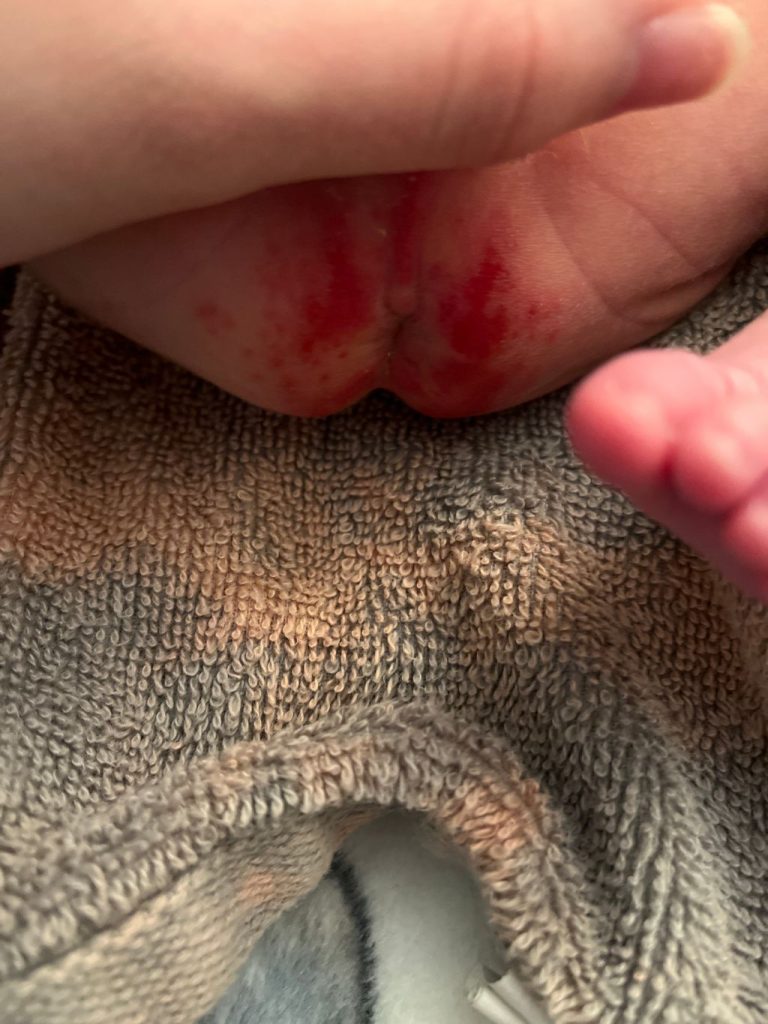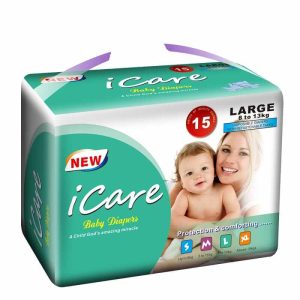Bleeding diaper rash in babies may result from severe irritation or infection. Immediate medical attention is recommended.
Diaper rash is a common issue that many parents face. It can cause discomfort and distress for babies. This condition often arises due to prolonged exposure to wet or soiled diapers. Harsh chemicals in wipes or diapers can exacerbate the problem.
Frequent diaper changes and proper hygiene can help prevent and treat diaper rash. Over-the-counter creams may soothe mild rashes, but severe cases with bleeding need medical evaluation. Consulting a pediatrician ensures the right treatment and alleviates your baby’s discomfort quickly. Identifying and addressing the root cause is crucial for effective management and prevention of further issues.
Common Causes
Diaper rash bleeding can be alarming for parents. Understanding the common causes can help in preventing and treating this issue. Below are some key reasons why your baby’s diaper rash might be bleeding.
Irritation From Diapers
Diapers can irritate your baby’s sensitive skin. Wet or soiled diapers can cause friction. This friction leads to chafing and irritation. Prolonged exposure to moisture also weakens the skin. Weak skin is more prone to bleeding.
To minimize irritation:
- Change diapers frequently
- Use breathable diaper materials
- Ensure a proper fit
- Apply a barrier cream
Allergic Reactions
Babies can be allergic to materials in diapers. Chemicals, dyes, and fragrances can trigger reactions. These reactions can cause severe rashes and even bleeding.
Signs of an allergic reaction:
- Red, inflamed skin
- Blisters or sores
- Itching and discomfort
To prevent allergies:
- Choose hypoallergenic diapers
- Avoid scented wipes
- Use natural fiber diapers

Credit: www.reddit.com
Signs Of Infection
Bleeding diaper rash may indicate an infection. Identifying the signs early is crucial. Infections can worsen quickly, needing prompt attention.
Fungal Infections
Fungal infections are common in diaper rashes. These infections thrive in warm, moist areas.
- Red, shiny patches that don’t improve with standard creams
- Raised borders or edges around the rash
- Small red bumps around the main rash area
- Itchiness causing discomfort to the baby
These signs suggest a yeast infection, often caused by Candida.
Bacterial Infections
Bacterial infections can turn a simple rash into a serious issue. They often follow untreated fungal infections.
- Yellowish crusts or pus-filled blisters
- Red, swollen skin that feels warm to touch
- Fever indicating the body is fighting an infection
- Spreading rash beyond the diaper area
These symptoms may point to a bacterial infection, often caused by Staphylococcus or Streptococcus.
Impact Of Moisture
Moisture is a major cause of diaper rash. When a diaper stays wet, it can irritate your baby’s skin. This can lead to a bleeding diaper rash. Keeping your baby’s skin dry is key to preventing this issue.
Prolonged Wetness
Prolonged wetness is a common cause of diaper rash. When a diaper stays wet for too long, it creates a moist environment. This moist environment is perfect for bacteria and fungi to grow. These germs can irritate the skin and cause a rash.
Here is a simple table showing how long wetness can affect the skin:
| Duration of Wetness | Impact on Skin |
|---|---|
| Less than 1 hour | Minimal irritation |
| 1 to 3 hours | Moderate irritation |
| More than 3 hours | High risk of rash |
Inadequate Drying
Inadequate drying after a diaper change can also cause issues. If the skin is not dried properly, it stays damp. This dampness can lead to a diaper rash. Here are some tips to ensure proper drying:
- Use a soft towel to pat the skin dry.
- Allow the skin to air dry for a few minutes.
- Avoid rubbing the skin harshly.
Ensuring your baby’s skin is dry helps prevent rashes and keeps them comfortable.

Credit: community.whattoexpect.com
Role Of Diet
A baby’s diet can impact diaper rash. Certain foods can aggravate the skin. Others can cause the rash to bleed. Understanding the role of diet is crucial for parents. Here’s how diet affects your baby’s diaper rash.
Acidic Foods
Acidic foods can worsen diaper rash. Foods like oranges and tomatoes are acidic. These foods can cause irritation and bleeding.
Common acidic foods to avoid:
- Oranges
- Tomatoes
- Pineapples
- Strawberries
Monitor your baby’s reaction to these foods. If the rash worsens, consult your pediatrician.
New Introductions
Introducing new foods can cause diaper rash. Babies’ digestive systems are sensitive. New foods can trigger allergic reactions.
Signs of food-related diaper rash:
- Red, inflamed skin
- Bleeding spots
- Increased discomfort
Introduce new foods one at a time. Keep a food diary to track reactions. This helps identify the cause of the rash.
Consult a pediatrician for guidance on introducing new foods safely.
When To Seek Medical Help
Seeing your baby in discomfort can be stressful. A diaper rash is common, but sometimes it needs medical attention. Knowing when to seek help is important for your baby’s health.
Persistent Rash
A diaper rash that doesn’t improve in a few days needs a doctor. Watch for rashes lasting more than a week. Your baby’s skin should heal quickly with proper care. If it doesn’t, medical advice is necessary.
Persistent rashes can indicate infections. Bacterial or fungal infections need treatment. Look for signs like pus, blisters, or fever. These symptoms need immediate medical care.
| Symptoms | Action |
|---|---|
| Rash lasting more than a week | Consult a doctor |
| Pus or blisters | Seek medical help |
| Fever | Immediate medical attention |
Severe Bleeding
Severe bleeding from a diaper rash is a red flag. Small spots of blood may occur with irritation. But large amounts of blood are alarming.
Bleeding can signal a deep infection. This needs prompt medical treatment. Don’t wait if you see significant blood. Your baby’s health could be at risk.
Look for other serious symptoms. Swelling, oozing, or a very red rash are concerning. These signs, along with bleeding, need a doctor’s visit.
- Large amounts of blood
- Swelling and oozing
- Very red rash

Credit: community.whattoexpect.com
Home Remedies
Dealing with a bleeding diaper rash can be distressing for both baby and parents. While consulting a pediatrician is important, several home remedies can offer relief. These remedies can help soothe your baby’s irritated skin and promote healing.
Natural Ointments
Natural ointments can be very effective in treating bleeding diaper rash. These ointments usually contain ingredients like aloe vera, coconut oil, and calendula. They have anti-inflammatory and healing properties.
- Aloe Vera Gel: Apply a thin layer on the affected area. Aloe vera has cooling and healing properties.
- Coconut Oil: Gently massage a small amount onto the rash. Coconut oil helps moisturize and protect the skin.
- Calendula Cream: Use this cream to reduce inflammation and promote healing. It’s safe for sensitive baby skin.
These natural ointments can be found at health stores or online. Always test a small amount on your baby’s skin first to check for any reactions.
Frequent Diaper Changes
Changing diapers frequently is crucial to prevent and treat diaper rash. Wet and soiled diapers can worsen the condition.
- Check Diapers Often: Inspect your baby’s diaper every 2-3 hours. Wet or soiled diapers should be changed immediately.
- Use Gentle Wipes: Opt for alcohol-free, unscented wipes. They are less likely to irritate the skin.
- Air Time: Give your baby some diaper-free time. Letting the skin breathe can speed up healing.
Frequent diaper changes reduce moisture and irritation, which are key contributors to diaper rash.
By using natural ointments and changing diapers frequently, you can help your baby feel better faster. These home remedies are simple yet effective methods to treat bleeding diaper rash.
Preventive Measures
Preventing diaper rash from bleeding is essential for your baby’s comfort. Taking specific steps can avoid this painful issue. Here are some key preventive measures to consider.
Proper Hygiene
Maintaining proper hygiene is crucial. Always keep your baby’s diaper area clean and dry. Frequent diaper changes help prevent prolonged exposure to moisture.
Use a soft cloth or cotton balls for cleaning. Avoid using harsh wipes that contain alcohol or fragrances. Warm water is best for cleaning the diaper area. Pat the skin dry gently with a soft towel.
Allow some diaper-free time daily. This lets the skin breathe and prevents irritation.
Choosing The Right Diaper
Selecting the right diaper can make a big difference. Opt for diapers that are highly absorbent and fit well. A good fit prevents leaks and reduces friction.
Consider using cloth diapers if your baby has sensitive skin. Cloth diapers are less likely to cause irritation. Always change the diaper as soon as it is wet or soiled.
Avoid using plastic pants over diapers. They can trap moisture and increase the risk of rash.
| Preventive Measure | Action |
|---|---|
| Proper Hygiene | Keep the diaper area clean and dry |
| Choosing the Right Diaper | Select highly absorbent and well-fitting diapers |
By following these preventive measures, you can help ensure your baby’s comfort. Proper hygiene and the right diaper choice are key to preventing diaper rash.
Consulting A Pediatrician
If your baby’s diaper rash is bleeding, it’s crucial to seek help. Consulting a pediatrician ensures your baby gets the right care. Bleeding can signal a more serious condition.
Getting A Diagnosis
The pediatrician will examine your baby’s skin closely. They may ask questions about your baby’s diet, diapering habits, and any recent changes. This helps in identifying the root cause. They might take a swab to rule out infections. Accurate diagnosis leads to effective treatment.
Treatment Plans
Once diagnosed, the pediatrician will suggest a treatment plan. This could include:
- Changing diaper brands
- Frequent diaper changes
- Applying prescribed creams or ointments
- Using hypoallergenic wipes
They may also recommend specific home care practices. These can include:
- Allowing your baby’s skin to air out
- Giving your baby more diaper-free time
- Avoiding tight diapers
Following the treatment plan can speed up healing. Always follow the pediatrician’s advice for the best results.
Frequently Asked Questions
What Causes A Baby’s Diaper Rash To Bleed?
Bleeding diaper rash is often due to severe irritation or infection. Frequent diaper changes, proper hygiene, and using barrier creams can help prevent it.
How Can I Treat Bleeding Diaper Rash?
To treat bleeding diaper rash, keep the area clean and dry. Use a thick barrier cream and let the baby go diaper-free when possible.
When Should I See A Doctor For Diaper Rash?
Consult a doctor if the rash bleeds, spreads, or doesn’t improve with home care. Persistent symptoms may indicate an infection needing medical treatment.
Can Certain Foods Cause Diaper Rash To Bleed?
Yes, acidic foods like citrus and tomatoes can worsen diaper rash. Monitor your baby’s diet and avoid potential irritants to prevent bleeding rashes.
Conclusion
Understanding why your baby’s diaper rash is bleeding is crucial for effective treatment. Identifying the cause helps you take the right steps. Consult your pediatrician for advice tailored to your baby’s needs. With proper care, you can alleviate discomfort and promote healing.
Always prioritize your baby’s health and comfort.




